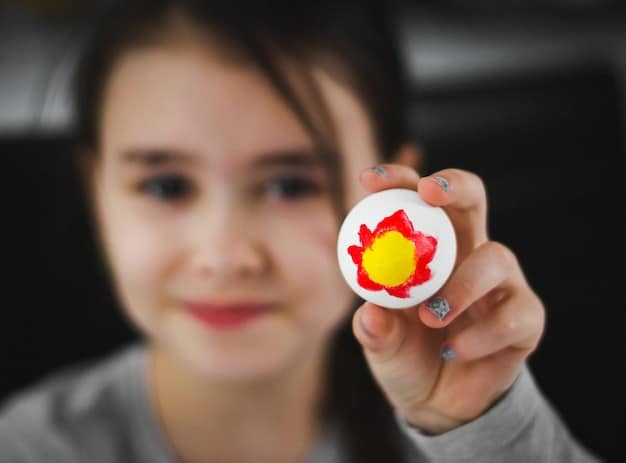Quit Smoking in 30 Days: A Step-by-Step Guide for Lasting Success

Achieving freedom from nicotine addiction is a profound journey, and this guide provides a structured, practical solutions: how to quit smoking in 30 days: a step-by-step guide, offering actionable strategies, expert insights, and consistent support to help you navigate withdrawal, build coping mechanisms, and sustain a smoke-free life within a month.
Embarking on the journey to quit smoking can feel daunting, yet it’s one of the most impactful decisions you can make for your health and well-being. This guide offers practical solutions: how to quit smoking in 30 days: a step-by-step guide, designed to empower you with a clear, actionable plan. We will delve into preparing for your quit date, managing cravings effectively, and building a robust support system to ensure your success in becoming smoke-free.
Understanding the Addiction and Setting Your Foundation
Quitting smoking isn’t just about willpower; it’s about understanding the complex interplay of physical and psychological addiction. Nicotine, the primary addictive substance in cigarettes, alters brain chemistry, creating a dependence that manifests as intense cravings and withdrawal symptoms when its supply is cut off. Beyond the physical, smoking often becomes deeply intertwined with daily routines, emotional states, and social interactions, making it a habit harder to break. Recognizing these multifaceted aspects of addiction is the critical first step towards developing an effective cessation strategy. True success comes from addressing both the body and the mind.
Before you even set a quit date, taking time to truly understand your relationship with smoking is invaluable. This self-assessment allows you to identify your personal triggers, the moments or emotions that most strongly compel you to light up. Is it stress? After meals? During coffee breaks? Social gatherings? Jotting these down creates a personalized map of your addiction, highlighting the specific challenges you’ll face. Armed with this knowledge, you can begin to devise tailored strategies for avoidance or management. This initial introspection builds a strong foundation, moving you beyond a vague desire to quit to a concrete plan based on self-awareness.
The Science Behind Nicotine Addiction
Nicotine addiction is more than a bad habit; it’s a chronic, relapsing disease that impacts the brain’s reward system. Each puff delivers nicotine rapidly to the brain, triggering a surge of dopamine, a neurotransmitter associated with pleasure and reward. This creates a positive feedback loop, reinforcing the smoking behavior. Over time, the brain adapts to the constant presence of nicotine, leading to tolerance and dependence. When nicotine is withdrawn, the brain’s chemistry is disrupted, resulting in withdrawal symptoms that can range from irritability and anxiety to intense cravings and difficulty concentrating. Understanding these neurobiological underpinnings helps demystify the struggle and validates the need for comprehensive support.
- Nicotine rapidly reaches the brain, influencing neurotransmitters.
- Dopamine release creates a rewarding sensation, reinforcing smoking.
- Brain adapts, leading to tolerance and physical dependence.
- Withdrawal symptoms occur when nicotine supply decreases.
Setting Your Quit Date and Informing Others
Choosing a specific quit date transforms a vague intention into a concrete goal. Ideally, pick a date within the next two weeks, allowing enough time to prepare without losing motivation. Announce your quit date to friends, family, and colleagues who support your decision. This act of public commitment can significantly boost your accountability and provide a crucial support network. Explain to them what you’re doing, why it’s important to you, and how they can best support you—whether it’s by not offering cigarettes, understanding your irritability during withdrawal, or simply being there to listen. Their encouragement will be invaluable during challenging moments.
Think of your support system as your personal cheerleading squad. When times get tough, it’s these individuals who can remind you of your goals and help you stay on track. Don’t be afraid to ask for specific types of help. Some people might need a distraction, others might need a listening ear, and some might need gentle reminders. Make sure those around you understand what you desire from them as you navigate this significant change in your life.
Establishing this foundation of understanding and clear goals is not merely preparatory work, but an integral part of the process itself. It means you are approaching this challenge not as a fleeting wish, but as a well-thought-out, strategic endeavor. By acknowledging the power of addiction and proactively building a supportive environment, you significantly increase your chances of long-term success. This initial groundwork sets the stage for a more effective and sustainable cessation journey, making the subsequent steps much more manageable.
Week 1: Navigating the Initial Challenges and Cravings
The first week after quitting smoking is often the most challenging, as your body begins to adjust to the absence of nicotine. Withdrawal symptoms can be intense, but understanding what to expect and having a range of coping mechanisms in place will be your greatest assets. This period is a test of your resolve, but it’s also when you start to feel the very first benefits of being smoke-free, which can act as powerful motivators. Focus on small victories and remind yourself why you started this journey in the first place. Every craving successfully overcome is a step closer to lasting freedom.
During this crucial week, your primary focus should be on managing cravings and discomfort. Many find that nicotine replacement therapy (NRT) or prescription medications can significantly alleviate withdrawal symptoms, making the quitting process more tolerable. These aids work by providing controlled doses of nicotine or by altering brain chemistry to reduce cravings, allowing you to focus on breaking the behavioral aspects of your addiction. Consult with a healthcare professional to determine which option is best suited for you, considering your smoking history and health profile. Combining these aids with behavioral strategies often yields the best results.
Managing Nicotine Withdrawal
Nicotine withdrawal symptoms typically peak within the first few days and gradually subside over several weeks. These can include irritability, anxiety, difficulty concentrating, increased appetite, and strong cravings. While uncomfortable, these symptoms are temporary and are signs that your body is healing. Employ strategies like deep breathing exercises, short walks, or engaging in a hobby to distract yourself. Staying hydrated and eating regular, healthy meals can also help regulate mood and energy levels. Remember, these feelings will pass, and each time you push through a craving, you’re strengthening your resolve.
- Identify withdrawal symptoms: irritability, cravings, anxiety.
- Utilize NRT (patches, gum, lozenges) or medication.
- Practice relaxation techniques (deep breathing, meditation).
- Stay active and hydrated throughout the day.
Coping with Cravings: The 4 D’s
Cravings are a natural part of quitting, but they are usually short-lived and manageable. A popular strategy for coping with cravings is the “4 D’s” approach: Delay, Deep Breath, Drink Water, Do Something Else. When a craving hits, delay lighting up for a few minutes; often, the urge will pass. Take a few slow, deep breaths to calm yourself. Drink a glass of water, which can help satisfy oral fixation and flush out toxins. Finally, engage in an activity that distracts you, whether it’s reading, calling a friend, or stepping outside. Regularly practicing these techniques can significantly reduce the impact of cravings on your day-to-day life.
Distraction is a powerful tool in your arsenal against cravings. When you feel the urge to smoke, immediately switch your focus to something else entirely. This could be anything from solving a puzzle to listening to your favorite music or engaging in a brief cleaning task. The key is to break the thought pattern associated with smoking and redirect your attention. Over time, your brain will start to associate these new activities with a sense of accomplishment rather than the fleeting relief smoking once provided. The more you practice these distractions, the less power cravings will have over you.

The first week sets the tone for your entire quit journey. While it may be intense, remember that hundreds of thousands of people have successfully navigated this period. Each day smoke-free is a victory, a monumental step towards a healthier future. By proactively addressing withdrawal symptoms and mastering craving management techniques, you gain momentum and confidence to continue your progress. This initial phase is about building resilience and confirming your commitment to a life without cigarettes.
Week 2: Building New Habits and Avoiding Triggers
As you enter the second week of your smoke-free journey, you may notice that the intensity of physical withdrawal symptoms begins to wane. This is an opportune time to shift your focus from merely enduring cravings to actively building new, positive habits and strategies for trigger avoidance. Many smokers associate cigarettes with specific routines—morning coffee, after meals, during work breaks, or social events. Breaking these associations is crucial for long-term success. This week is about consciously replacing old, harmful patterns with healthy, empowering alternatives that support your new smoke-free identity.
Identifying your personal smoking triggers is a foundational exercise. These can be emotional (stress, boredom, sadness), environmental (the car, specific locations), social (friends who smoke), or habitual (after certain activities). Once identified, you can either avoid these triggers or develop a pre-planned response. For instance, if stress is a trigger, replace smoking with meditation or a quick walk. If specific friends trigger you, suggest smoke-free activities or explain your boundaries. Proactive avoidance and substitution are key during this phase, preventing you from falling back into old patterns by surprise.
Replacing Old Habits with Healthy Alternatives
A significant part of quitting smoking involves re-engineering your daily routines to remove cigarette cues. For example, if you always smoked with your morning coffee, try replacing coffee with tea or changing your morning routine entirely. If you smoked after meals, immediately brush your teeth or go for a short walk instead. The goal is to fill the void left by smoking with activities that are both enjoyable and beneficial to your health. This might include taking up a new hobby, engaging in regular physical activity, or spending more time on self-care. The more you integrate these new, positive behaviors, the less you’ll feel the pull of your old smoking habits.
- Identify routine-based triggers (e.g., coffee, meals).
- Substitute smoking with positive new activities (e.g., walking, hobbies).
- Change your environment to remove smoking cues.
- Practice mindfulness to reframe your thoughts.
Developing Effective Stress Management Techniques
Stress is a common trigger for many smokers. Learning healthy ways to manage stress is vital for long-term success. Instead of reaching for a cigarette, consider practicing mindfulness, meditation, or yoga. Even simple deep-breathing exercises can rapidly reduce stress levels. Regular physical activity is also a powerful stress reliever, boosting mood and energy. If stress remains a significant challenge, seeking professional support from a therapist or counselor can provide you with additional coping strategies tailored to your needs. Mastering stress management not only helps you stay smoke-free but also improves your overall quality of life.
Social situations can also pose a significant challenge, especially if many of your friends smoke. Develop strategies for declining offers to smoke gracefully. You might say, “No thanks, I’m quitting,” or “I’m focusing on my health right now.” It’s also helpful to have smoke-free friends or environments where you feel comfortable. If you’re attending a social event where smoking is prevalent, plan an exit strategy or bring a supportive friend to help you stay on track. This proactive approach to social triggers ensures that you maintain control over your choices, reinforcing your commitment to being smoke-free.
The second week is less about fighting symptoms and more about building a new normal. By consciously replacing old habits and diligently avoiding or managing triggers, you begin to reshape your identity from a smoker to a non-smoker. This phase is crucial for establishing sustainable behavioral changes that will serve as pillars for your continued success. Embrace this period of transformation, recognizing that each new healthy habit strengthens your resolve and brings you closer to permanent freedom from nicotine.
Week 3: Embracing Benefits and Staying Motivated
As you enter your third week of being smoke-free, many of the acute withdrawal symptoms should have significantly diminished. This pivotal phase is less about combating intense physical urges and more about recognizing and celebrating the tangible benefits you’re already experiencing. Your body is undergoing remarkable healing processes, and acknowledging these improvements is a powerful motivator to reinforce your commitment. This week, focus on connecting with the positive changes, reflecting on your progress, and solidifying your smoke-free identity. It’s about shifting from managing struggle to embracing newfound health and freedom.
One of the most immediate benefits you’ll likely notice is an improvement in your sense of taste and smell. Food will taste richer, and the world will suddenly seem more vibrant. Beyond these sensory changes, your breathing will become easier, and you’ll likely have more energy for daily activities. Internally, your cardiovascular system is already beginning to repair itself, reducing your risk of heart attack and stroke. Your lungs are starting to clear out tar and toxins, leading to improved lung function. Take a moment to truly appreciate these changes; they are concrete evidence of the positive impact your decision has had.
Recognizing Health Improvements
Within just 20 minutes of quitting, your heart rate and blood pressure begin to drop. After 12 hours, the carbon monoxide level in your blood returns to normal. By two weeks to three months, your circulation improves, and lung function increases. These aren’t just statistics; they are real, measurable changes happening within your body. Think about how much easier it is to walk up stairs or how your morning cough has lessened. Keeping a journal to track these improvements can serve as a constant reminder of your progress, turning abstract health benefits into personal victories. Celebrating these milestones is key to maintaining high morale.
- Improved taste and smell sensation.
- Easier breathing and increased energy levels.
- Cardiovascular health begins to recover.
- Lung function starts to improve, reducing coughs.
Maintaining Motivation and Avoiding Relapse
While the initial hurdles may be behind you, staying motivated is an ongoing process. Continue to remind yourself of your reasons for quitting—whether it’s for your health, your family, or financial savings. Visualization can be a powerful tool: imagine yourself living a long, healthy life free from the constraints of addiction. Reward yourself periodically for reaching milestones, but choose non-smoking rewards like a massage, a new book, or a fun outing. This reinforcement strengthens positive associations with being smoke-free.
It’s important to understand that relapse is a part of the journey for many people, but it doesn’t mean failure. If you slip up, don’t view it as the end of your quit attempt. Instead, analyze what triggered the lapse, recommit to your goal, and learn from the experience. Forgive yourself, and immediately get back on track. Building a strong support system remains crucial; lean on friends, family, or support groups when you feel your motivation wavering. Remember, every day you don’t smoke is a triumph, and your commitment to a healthier life is invaluable.

The third week is a period of reinforcement and empowerment. By actively observing and appreciating the health benefits, you transform the abstract goal of quitting into a tangible reality. This newfound appreciation fuels your motivation and strengthens your resolve, setting the stage for long-term success. It’s exhilarating to feel your body healing and to experience life with greater vitality. Embrace this phase, as it provides the positive feedback necessary to cement your smoke-free future.
Week 4: Solidifying Your Smoke-Free Lifestyle
As you enter your fourth and final week of the 30-day program, you’ve achieved a significant milestone. Many of the physical symptoms of nicotine withdrawal are now gone, and you’ve likely settled into new, healthier routines. This week is about solidifying these changes and preparing for long-term maintenance. The focus shifts from active quitting to embracing a smoke-free lifestyle as your new normal. This means reinforcing your coping mechanisms, planning for potential challenges, and continuing to build a strong support system that will sustain your success far into the future. You are not just quitting smoking; you are becoming a non-smoker, a vital shift in identity.
Even though the initial battle with cravings may be over, vigilance is still key. Occasional urges might still surface, especially in high-stress situations or around old triggers. Have a plan for these moments. Revisit your “4 D’s” strategy or whatever coping mechanisms worked best for you in the earlier weeks. This continued preparedness ensures that you won’t be caught off guard. Think of this week as polishing your new healthy habits, making them so ingrained that they become effortless. This consolidation phase is vital for sustained remission from nicotine addiction.
Developing Long-Term Strategies for Maintenance
Maintaining a smoke-free life extends beyond the 30-day mark. Develop long-term strategies, such as maintaining regular physical activity, which is proven to reduce stress and improve mood, lessening the urge to smoke. Continue to practice healthy eating habits to manage weight gain, a common concern for ex-smokers. Identify new hobbies or activities that bring you joy and distraction, providing healthy outlets for energy and emotions. Regularly review your progress and celebrate your victories, no matter how small, to reinforce your commitment. Consistency in these areas builds a robust defense against relapse.
- Commit to regular physical activity.
- Maintain a balanced, healthy diet.
- Engage in new hobbies and interests.
- Revisit your initial reasons for quitting.
Building a Strong Support System
Your support system isn’t just for the first tough weeks; it’s a lifelong asset. Continue to communicate openly with friends and family who support your journey. Consider joining a support group, either in person or online, where you can share experiences and advice with others who understand what you’re going through. Having a network of people who can offer encouragement and accountability is invaluable. Remember, it’s okay to ask for help, and leaning on others when needed is a sign of strength, not weakness. A strong support network buffers against isolation and reinforces your commitment.
Reflecting on your journey this past month can also be incredibly motivating. Think about how far you’ve come, the challenges you’ve overcome, and the benefits you’re now enjoying. This self-acknowledgment strengthens your belief in your ability to stay smoke-free permanently. Visualize your smoke-free future—a life with more energy, better health, and financial freedom. This positive reinforcement solidifies your new identity as a non-smoker, making it an integral part of who you are. This final week is about empowerment and looking forward with confidence.
By the end of your 30-day journey, you’ve not only quit smoking but have also established strong foundations for a healthier, smoke-free future. This period of consolidation ensures that the habits and strategies you’ve developed become second nature, equipping you to handle any future challenges. Embrace this new chapter with confidence, knowing that you possess the tools and resilience to maintain your freedom from nicotine. This is more than just stopping smoking; it’s about starting a new, vibrant life.
Addressing Common Hurdles and Long-Term Strategies
Even after successfully completing the initial 30-day challenge, the journey to a completely smoke-free life often involves navigating various hurdles. These can range from unexpected cravings triggered by specific situations to dealing with weight gain or persistent psychological dependence. Recognizing that these challenges are normal and having a proactive approach to address them is crucial for long-term cessation. Sustaining your success means developing personalized strategies and adapting to your evolving needs, ensuring that you maintain resilience against the temptation to relapse. This phase is about long-term vigilance and self-care.
One of the most insidious challenges can be complacency. Once the tough withdrawal symptoms subside, it’s easy to think the battle is over. However, smoking is a chronic condition, and occasional urges can resurface years later. Remain aware of potential triggers and continue to employ your coping mechanisms, even if they feel like second nature. Regularly reviewing your reasons for quitting and celebrating your milestones can help keep your motivation strong and prevent you from taking your smoke-free status for granted. This ongoing commitment to self-care is essential for permanent freedom.
Managing Weight Gain After Quitting
Many individuals worry about weight gain when they stop smoking. Nicotine can suppress appetite, and quitting can sometimes lead to increased hunger or a desire to replace the oral fixation of smoking with food. To counter this, focus on a balanced diet rich in fruits, vegetables, and lean proteins. Incorporate regular physical activity into your routine, which not only helps manage weight but also reduces stress and improves mood. If concerns about weight gain are significant, consult a dietitian or healthcare professional for personalized advice. Addressing this concern proactively helps remove a common barrier to sustained quitting.
- Focus on a healthy, balanced diet.
- Increase physical activity to manage weight.
- Consult a dietitian for personalized strategies.
- Avoid replacing cigarettes with unhealthy snacks.
Overcoming Psychological Dependence and Relapse Prevention
While physical cravings subside, the psychological association of smoking with routines, emotions, and social situations can linger. This psychological dependence requires ongoing attention. If you find yourself frequently thinking about cigarettes, revisit your coping strategies. Engaging in stress-reducing activities like meditation, yoga, or hobbies can provide healthy outlets. It’s vital to have a relapse prevention plan in place. This includes identifying high-risk situations (e.g., alcohol consumption, stress, social events with smokers) and pre-determining how you will handle them. Remember that a slip-up is not a failure; it’s an opportunity to learn and recommit. Immediately get back on track and reinforce your resolve. Therapy or counseling can also provide tools for managing persistent psychological urges.
Seeking professional help is not a sign of weakness but a strategic advantage. Behavioral therapy, cognitive-behavioral therapy (CBT), or counseling can provide you with additional tools and perspectives for maintaining your smoke-free status. These professionals can help you identify deep-seated triggers, develop personalized coping strategies, and manage any underlying issues that contribute to urges. Support groups, both in-person and online, also offer a powerful sense of community and shared experience, allowing you to learn from others’ successes and challenges. Utilizing these resources significantly bolsters your long-term prevention efforts.
Long-term success in quitting smoking is a continuous process of learning, adapting, and reinforcing your commitment. By proactively addressing potential hurdles like weight gain and psychological dependence, and by leveraging professional and community support, you build an unshakeable foundation for a smoke-free life. Your journey extends beyond 30 days, continually empowering you towards lasting health and freedom.
Celebrating Success and Looking to the Future
Reaching the end of your 30-day journey represents a monumental achievement, a testament to your determination and resilience. This period of intense focus on quitting has not only freed you from nicotine’s grip but has also laid the groundwork for a healthier, more vibrant future. Take a moment to genuinely celebrate this success. It’s an opportunity to acknowledge the hard work you’ve put in and to reflect on how far you’ve come. Celebrating milestones reinforces positive behavior and strengthens your resolve for long-term abstinence. This isn’t just about stopping a bad habit; it’s about embracing a new, empowered version of yourself.
The benefits of quitting smoking are cumulative and extend far beyond the initial month. As time progresses, your risk of developing smoking-related diseases continues to decrease significantly. Your energy levels will increase, your skin complexion may improve, and your overall quality of life will soar. Beyond the physical, you’ll likely experience increased self-esteem and a sense of accomplishment that carries over into other areas of your life. Focusing on these long-term gains can serve as a powerful ongoing motivator, reinforcing your decision every single day. This is an investment in a healthier, happier you.
Acknowledging Milestones and Rewards
Breaking free from smoking is a series of small and large victories. It’s crucial to acknowledge these milestones. Whether it’s being smoke-free for a day, a week, a month, or a year, each one is worth celebrating. Choose non-smoking rewards that genuinely excite you – maybe a new gadget, a weekend getaway, or a special meal out. These rewards provide positive reinforcement and help your brain associate being smoke-free with pleasure and accomplishment. Share your successes with your support system; their encouragement will amplify your joy and commitment.
- Celebrate every milestone, no matter how small.
- Choose non-smoking rewards that motivate you.
- Share your successes with supportive friends and family.
- Keep a journal of benefits and achievements.
Embracing a Lifetime of Freedom
The 30-day program is a powerful launchpad, but maintaining a smoke-free life is an ongoing journey. Embrace this new identity as a non-smoker with confidence and pride. Continue to prioritize your health, engage in activities that bring you joy, and maintain a vigilant awareness of potential triggers. Remember that occasional urges might still occur, even years down the line, but you now have the tools and experience to manage them effectively. Stay connected with your support network, and don’t hesitate to seek professional guidance if you feel your resolve weakening. Your commitment to a smoke-free life is a gift to yourself, ensuring a future filled with vitality and well-being.
Plan for your future by thinking about how you’ll handle significant life events or highly stressful periods without resorting to smoking. This forward-thinking approach, coupled with the robust coping mechanisms you’ve developed, will equip you for any challenge. Your journey serves as an inspiration to others, demonstrating that freedom from addiction is truly achievable with perseverance and the right strategies. Live fully, breathe freely, and enjoy every moment of your newfound health and autonomy.
Your 30-day journey culminates in a profound transformation. By celebrating your success, acknowledging the ongoing benefits, and committing to lifelong maintenance, you solidify your freedom from nicotine. This achievement isn’t just about quitting; it’s about stepping into a brighter, healthier future, one breath at a time. The power to stay smoke-free rests within you, fueled by the dedication and strategies you’ve diligently cultivated.
| Key Point | Brief Description |
|---|---|
| 📊 Self-Assessment | Understand your triggers and relationship with smoking before starting. |
| 💡 Craving Management | Utilize the 4 D’s (Delay, Deep Breath, Drink Water, Do Something Else) to overcome urges. |
| 🩹 New Habits | Replace smoking routines with healthy alternatives and stress reduction techniques. |
| 🚀 Long-Term Success | Build a strong support system and celebrate milestones for sustained freedom. |
Frequently Asked Questions About Quitting Smoking in 30 Days
Yes, it is absolutely realistic for many people to quit smoking within 30 days. While the physical withdrawal symptoms typically peak in the first week, this timeframe allows sufficient time to break behavioral patterns and establish new, healthier routines. Success relies on preparation, a clear plan, and consistent effort to manage cravings and triggers during this intensive period. It’s a challenging but highly achievable goal.
Common withdrawal symptoms include irritability, anxiety, difficulty concentrating, increased appetite, and strong cravings. Physically, they typically peak within the first 3-5 days after quitting and gradually subside over the next 2-4 weeks. Psychological cravings, however, can linger for months or even years. Nicotine Replacement Therapy (NRT) or medication can significantly alleviate these symptoms during the crucial initial period.
Absolutely. Nicotine Replacement Therapy (NRT) is highly recommended and can significantly increase your chances of success. Products like patches, gum, lozenges, inhalers, or nasal sprays provide controlled doses of nicotine, reducing withdrawal symptoms and making the process more manageable. Consult your healthcare provider to determine the best NRT product and dosage for your specific needs, ensuring safe and effective use.
A slip-up is not a failure of your entire quit attempt. If you smoke a cigarette, don’t despair or give up. Instead, view it as a learning opportunity. Analyze what triggered the relapse, forgive yourself, and immediately recommit to your goal. Dispose of any remaining cigarettes and get back on your smoke-free path. Contact your support system for encouragement and revisit your coping strategies to get back on track swiftly.
Managing weight gain often involves integrating healthy habits into your new smoke-free lifestyle. Focus on maintaining a balanced diet rich in fruits and vegetables, and limit high-calorie snacks. Incorporate regular physical activity, which not only helps burn calories but also reduces stress and improves mood. Staying hydrated by drinking plenty of water can also help control appetite. Consult a healthcare professional or dietitian for personalized guidance.
Conclusion
Successfully navigating the 30-day journey to quit smoking is a transformative achievement that sets the stage for a lifetime of improved health and well-being. By understanding the nature of addiction, setting clear goals, actively managing cravings and triggers, and building a robust support system, you empower yourself to overcome this significant challenge. Each step, from the initial intention to celebrating your ongoing freedom, reinforces your commitment to a smoke-free life. Embrace the profound benefits of this decision and continue to prioritize your health, knowing that you hold the power to maintain your newfound freedom permanently.





